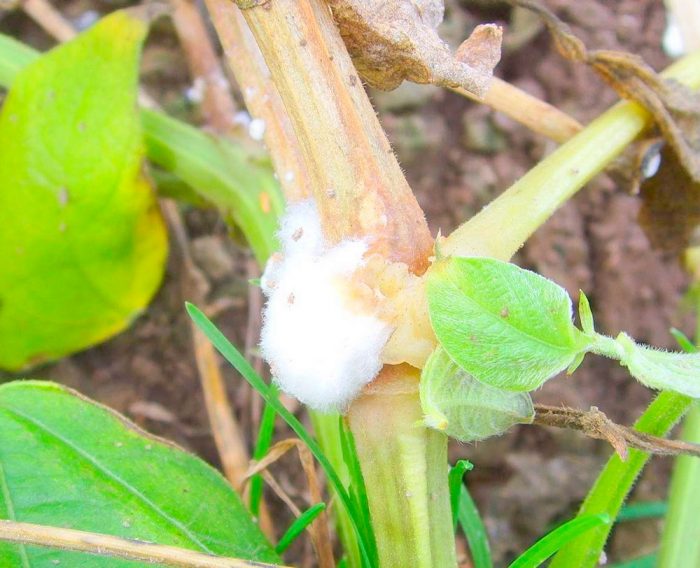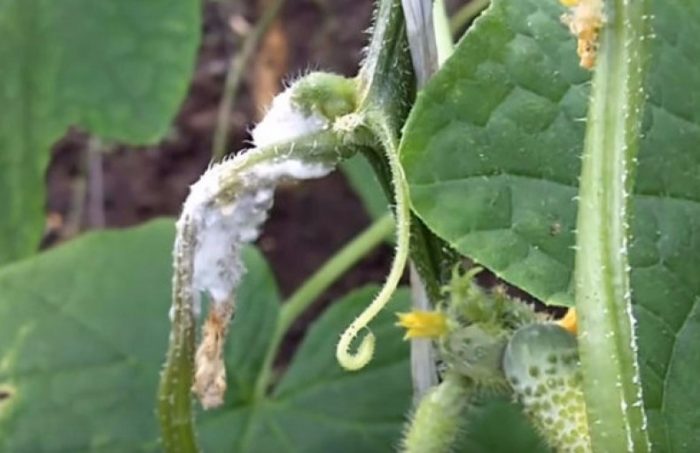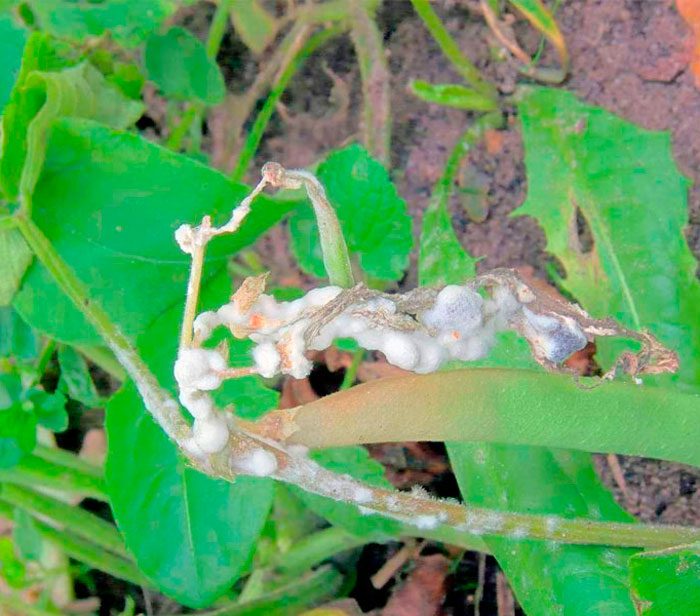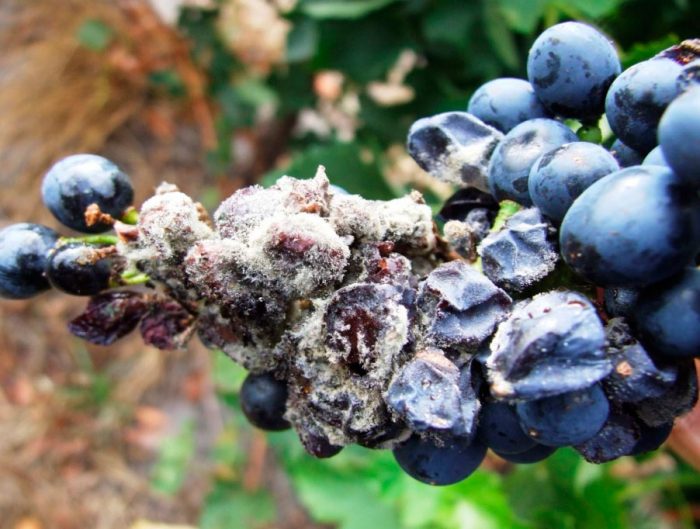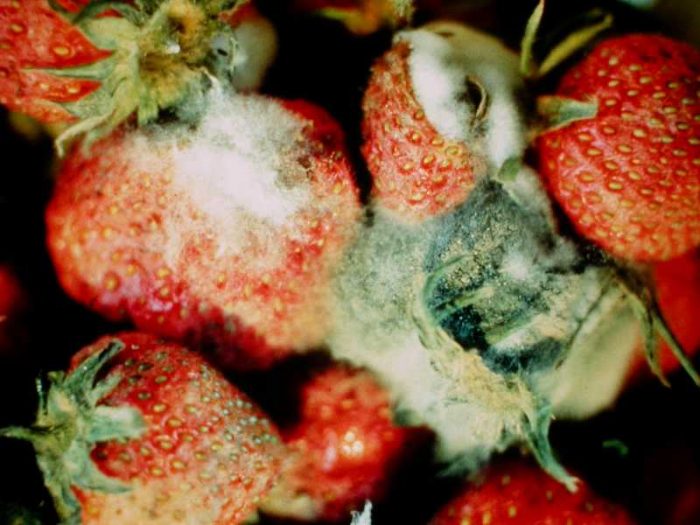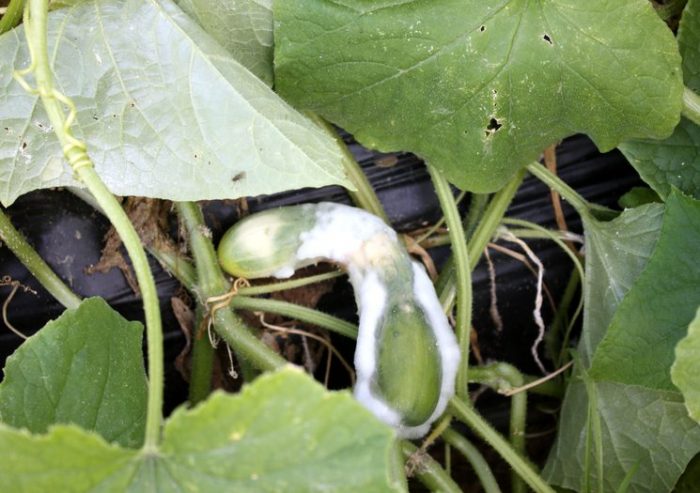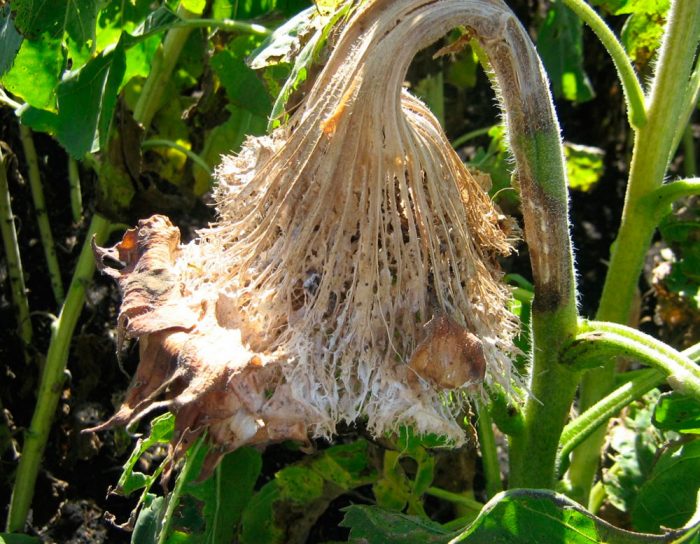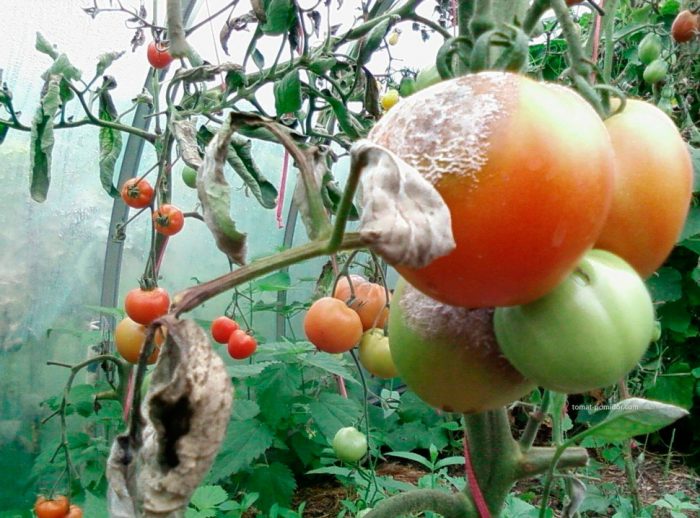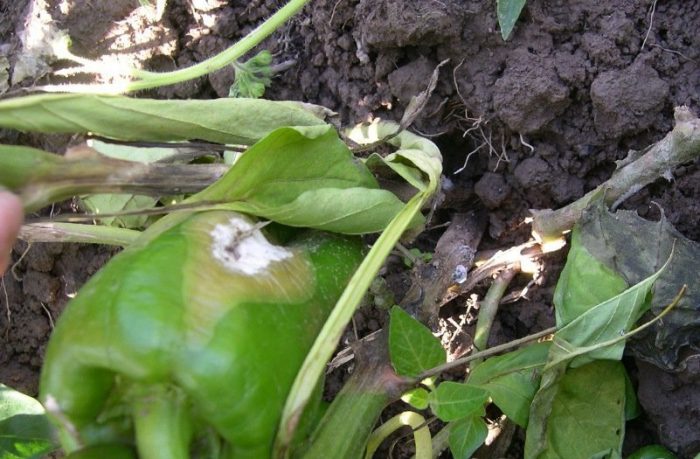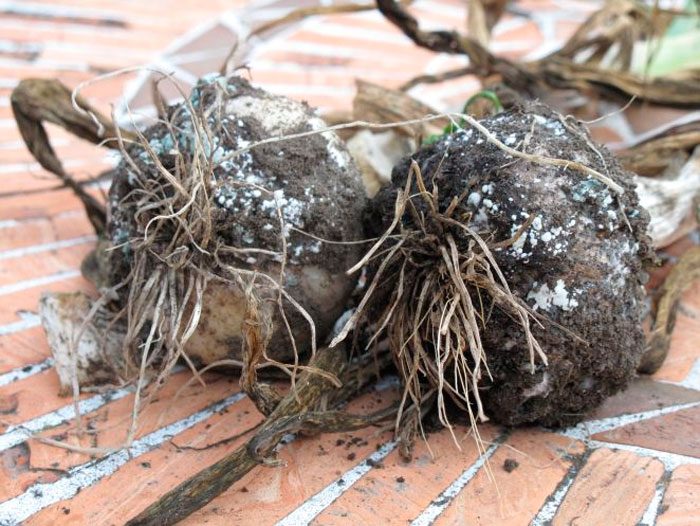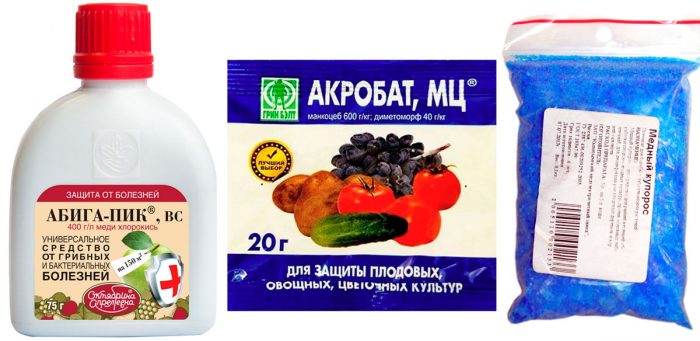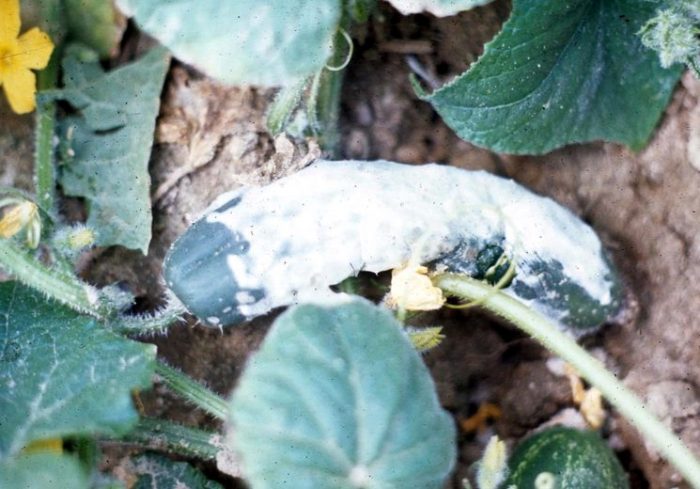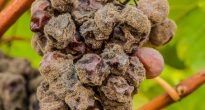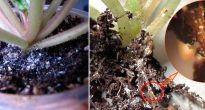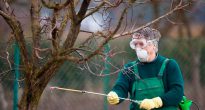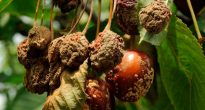White rot, also called sclerotinosis, is most commonly caused by the marsupial fungus Sclerotinia sclerotiorum. A variety of crops are affected by this disease, for example: cabbage, carrots, potatoes, sunflowers, Jerusalem artichoke, peas, grapes, and other plants, both wild and cultivated. Representatives of this genus of mushrooms in mid-latitudes can be found everywhere.
Content
Features of white rot
The most active development of white rot occurs in greenhouses and greenhouses, because in closed ground conditions are most favorable for the growth of a pathogenic fungus, or rather, there is high air humidity and poor ventilation. The disease is also actively developing in storage facilities. Both underground and aboveground parts of the bush suffer from sclerotiniasis. So, there is a wilting of the upper parts of the bush, the shoots in the root area rot, the foliage becomes discolored, it becomes watery, and a white bloom forms on its surface. On the cut of the shoot of the affected plant, black sclerotia of the fungus are clearly visible, and in some cases they also appear on the surface of the organs. As a rule, the damage to the plant occurs through the soil, and the disease actively develops in a cool environment (from 12 to 15 degrees), subject to high humidity and a sharp change in temperature.
Fighting white rot
To get rid of white rot, the problem must be approached comprehensively. If you fight the disease only with chemicals, then you will not be able to achieve a lasting result. To maintain the health of the plant, it is imperative to adhere to the agrotechnical rules of culture, properly care for the plant and not forget about the prevention of disease. The fact is that plants with very strong immunity are rarely affected by various diseases.
In the affected bushes, treat the diseased areas with a healing composition that you can prepare yourself, for this, combine a strong solution of potassium permanganate and crushed chalk. Before proceeding with the processing, first cut out all problem areas with the capture of healthy tissue. If there are a lot of affected areas on the bush or they occupy too much surface area of the bush, then experts advise that such a plant should not be cured, but dug up and burned.
For spraying diseased plants, such agents are used as: Euparen multi, copper sulfate, Hom, Rovral, Bordeaux liquid, Oxyhom, Abiga-Peak or other fungicidal preparations containing copper. Also, in the fight against white rot, such means as: Topaz, Topsin, Previkur, Ridomil Gold, Profit Gold, Skor, Fundazol, Ordan, Acrobat MC are very effective, but they need to be used after a season, otherwise addiction may develop.
Prevention measures
Since the development of sclerotinosis is promoted by high air humidity, it is necessary to ensure that its level is not higher than necessary, and also provide the plants with good ventilation. Since pathogenic fungi are in the soil, it must be disinfected before sowing or planting. When planting domestic plants, the soil mixture can be disinfected in the oven or microwave. And the soil in the garden or in the garden should be shed with a solution of Fungistop or Fundazol, this must be done three days before planting. When planting in the open ground of any culture, it is imperative to adhere to the scheme recommended by experts. The emerging seedlings often need thinning, because thickened plantings are easily affected by various fungal diseases.
The garden and garden plot must be cleared of weeds in a timely manner, and also do not forget to systematically carry out preventive spraying of crops from harmful insects and diseases. When the crop is harvested, remove all plant residues from the surface of the site and dig it up. Before storing the crop, the storage must be disinfected. Also, do not forget to sort out the fruits, choose absolutely whole and healthy ones for storage. Periodically in the winter, check the fruit in the storage, while removing those that show signs of spoilage.
Treatment of fruit and berry crops
White rot of grapes
It happens that in summer, after a long hot dry period, prolonged rains begin, and then sultry weather sets in again. The defeat of the fungus conigthyrium diplodiella of grapes occurs precisely in such conditions, while the development of the disease takes place in 2 stages: at first, the fruits look like boiled, and later the bushes begin to dry out. During the first stage, an intensive reproduction of the mycelium is observed, and during the second stage, which lasts much longer, the appearance of pycnidia of the fungus occurs on the surface of fruits and foliage. In grapes affected by white rot, the appearance of diseased foliage does not change very much, it dries up, it darkens, but the leaves do not fly off the bush. On the affected stems of the culture, necrotic spots of annular shape appear, as well as ulcers and longitudinally located cracks. And on diseased fruits, spots of yellow color first appear, as the disease develops, they change their color to bluish-brown. The fruits lose their turgor, the skin rises on them, and cavities appear under it, in which there is air, because of this it may seem that the grapes are covered with a white bloom. First of all, sclerotinosis affects the fruits that are outside, but in just four days the disease can destroy the entire bunch. Affected grapes fall off and end up in the ground, where pathogenic fungi can easily overwinter, and with the onset of the spring period they become active again.
What to do when the first signs of white rot damage to grapes are detected? To begin with, try to completely eliminate all contact of the bunches with the soil surface. After that, cut off all diseased areas from the bushes and within 24 hours process all the grapes, as well as the surface of the earth under the bushes, for this you can use fungicidal preparations containing copper.The soil on the site must be processed without fail, otherwise the fungus in it will be able to winter calmly, and in early spring it will again begin to actively infect the grape bushes.
White rot on strawberries
Sclerotiniasis can also infect strawberries (garden strawberries) under certain weather conditions. Most often, such a berry culture is affected by gray rot, but sclerotinosis is no less dangerous for it. You can understand that the bush is affected by white rot by a white cotton-like bloom with an irregularly shaped black sclerotia. During the development of the disease, all diseased berries become watery, and rot appears on them.
It is very difficult to cure strawberry bushes affected by sclerotinosis, since the first step is to try so that no fruit comes into contact with the surface of the earth. A good preventive measure in this case would be the cultivation of such a berry crop in a suspended structure or on a film. If your garden strawberry grows on a regular bed, then first cut out all the affected parts of the bushes, and then treat the surface of the soil and plants with a solution of a fungicidal preparation. Finally, cover the surface of the land on the site with a layer of mulch (any organic material).
Treatment of garden crops
White rot on cucumbers
White rot in cucumbers damages both the aerial parts of the bush and the roots. Weeping spots form on the affected shoots, which first appear in the root area, and then gradually spread to the entire stem. After that, a cotton-like outgrowth of mycelium appears on the surface of the spots, while mucus is systematically released from it, which flows from the bush and affects still healthy plants. Over time, the shoots become soft and slimy, while black sclerotia appear on the mycelium. Diseased plants wither, and their foliage loses its turgor and dries up. In fact, apparently healthy fruits cannot be eaten, they rot rapidly, even if they are cooked. The greatest harm sclerotinosis can cause cucumbers when they are grown annually in the same place, as well as bushes growing in unheated greenhouses, which are not well ventilated. The acceleration of the development of the disease is facilitated by thickening of the plantings.
As soon as the first signs of white rot are found, you need to immediately begin to fight the disease:
- Reduce the humidity level; for this, do not water or feed the cucumbers for at least 7 days.
- Trim off all affected parts of the bush.
- Treat cucumbers with a warm solution of Oxychom or Topaz, for this choose a dry, calm, but cloudy day.
- After processing cucumbers growing in the greenhouse, be sure to ventilate it, but at the same time monitor the air temperature (it should be the same as recommended on the packaging with the fungicidal preparation).
In the event that the disease is just beginning to develop, it is recommended to cut out the affected areas as soon as possible, using a disinfected pruner for this, while it is imperative to capture healthy tissue. The root area and the place of the cut must be sprinkled with fluff lime or coal powder. When the bush is processed, it is fed on foliage, using a solution consisting of a bucket of water, 2 grams of copper sulfate, 10 grams of urea and 1 gram of zinc sulfate. If the plant is very badly affected, then it must be dug up and destroyed.


Watch this video on YouTube
White rot on sunflower
In sunflower seedlings affected by sclerotinosis, the root system or the hypocotal knee decays. On adult bushes affected by the disease, rotting brown spots, covered with a white bloom, form on the surface of the stem. As the disease progresses, milling and breaking of the stem occurs.Also, wet spots of a dark color appear on the basket, they are covered with a felt bloom of the mycelium. Both the cap and the seeds of the inflorescence rots.
In order to prevent the disease, it is imperative to adhere to the rules of crop rotation, to grow varieties that are resistant to fungal diseases, after harvesting, it is imperative to clear the site of plant residues, and in the fall you need to dig up or plow the soil. During the growing season, for the treatment of sclerotinosis on sunflower, Pictor is used.


Watch this video on YouTube
White rot on tomatoes
Sclerotiniasis on tomatoes is caused by the pathogen Sclerotinia libertiana Fuckce. They penetrate the bushes through mechanical damage, and pathogenic fungi are activated in the cool, with high humidity and thickened plantings. Tomato disease can be affected both through shoots and foliage, and through fruits. Affected tissues turn yellow, mucus and white flocculent plaque appear on their surface, their softening is also observed, and cracks form on the skin of diseased fruits. Pathogenic fungi can survive in the ground and also on plant debris. Therefore, after collecting the fruits, it is imperative to remove the remnants of the bushes from the site, and also to dig the earth.
In order to preserve the harvest and prevent the defeat of tomatoes by white rot, the recommended preventive measures should be followed:
- follow the rules of crop rotation;
- the greenhouse should have an optimal level of humidity and temperature;
- do not allow thickening of the landings.
The soil in the greenhouse and on the site must be systematically disinfected, while the tomatoes are sprayed on the foliage with the following solution for prevention purposes: 1 gram of zinc sulfate, 2 grams of copper sulfate and 10 grams of urea are dissolved in a bucket of water. If the damage on the plant is not very strong, then all the affected areas are cut out with a sharp sterile instrument, capturing healthy tissue, and the cut sites are smeared with pink paste (how to do it is described above). Instances that are very severely affected are dug up and burned, and those bushes that remain and the surface of the soil on the site are sprayed with a solution of Oxyhom, Abiga-Peak, Euparen multi, Hom, Rovral, copper sulfate or Bordeaux liquid.
White rot on pepper
Sclerotiniasis can also affect peppers, as a result of which the stem is destroyed in the root part. At the beginning, a white bloom appears on the surface of the stem, and over time black sclerotia form on it, and then a fungus appears, which poisons the entire plant. The disease develops most actively in the cool (about 15 degrees) with high humidity.
Preventive measures:
- Before planting pepper seedlings, the soil must be disinfected, and such a distance is maintained between the bushes that each of them is well blown with air.
- Use lukewarm water for irrigation.
- Plants with sclerotinosis are dug up and burned as soon as possible. The bushes remaining in the garden and the soil surface are sprayed with the same preparations as for the defeat of tomatoes (see above).
White rot on garlic and onions
Onions and garlic are also susceptible to sclerotinia infection when grown on site and in storage. The fact that the onion is affected by white rot can be understood by the foliage, which begins to turn yellow from the tips, and then completely dies off. In affected garlic, the development of chlorosis on the foliage occurs from the bottom up. After that, a plaque of mycelium forms on both the garlic and onion scales, which is very similar to cotton wool. A slimy rot appears under this bloom. On diseased bulbs, many small black sclerotia of the fungus appear. As the disease develops, the plant dies.Most often, weakened bushes, which are watered with cold water, die. If already adult bushes are affected by white rot, then the bulbs rot in the storage, in this case, a white mycelium with black small sclerotia forms on the bottom. If only one garlic clove is sick, then the death of the entire head is inevitable.
If the humidity is high and the air temperature is optimal for infection, then its development occurs most rapidly in slightly acidic soil (pH 5.5). But it is recommended to grow both garlic and onions in slightly alkaline or neutral soil, in this regard, when preparing the garden for planting, it is recommended to neutralize the acidic soil. You should also not forget about the rules of crop rotation: in the area where onions and garlic grew, these crops cannot be planted for several years. Before sowing or planting, garlic cloves and sets are recommended to be disinfected for 30 minutes in a Fundazole solution (2%), or they are treated with a TMTD suspension (3%) for 5 minutes. The seedlings that have appeared should be systematically examined and at the first signs of the disease, all affected plants are dug up and destroyed, while the area where they grew should be covered with a thin layer of lime.
Preparations for white rot (fungicides)
As mentioned above, white rot is fought with the help of fungicidal preparations, so a brief description of them will be given below:
- Abiga Peak... It is a broad spectrum agent containing copper. It is used in the fight against many fungal and bacterial diseases.
- Acrobat MC... The drug is characterized by systemic and local action. It is used for various fungal diseases, for example, sclerotinosis, alternaria, mildew, late blight, peronosporosis, etc.
- Bordeaux mixture... Such a contact fungicidal preparation has a broad spectrum of action. It is used not only for treatment, but also to protect melons, fruits, flowers, berries, vegetables, citrus and ornamental crops from a variety of diseases.
- Copper sulfate... This contact agent, containing copper, is used to treat plants for many different diseases and has a wide spectrum of action.
- Oxyhom... This broad-spectrum systemic contact drug is used to treat those diseases that are caused by fungi of the oomycete subclass.
- Ordan... Such a contact-systemic agent is used to treat various plants affected by fungal diseases (for example, white rot and late blight). It can be used both in the greenhouse and in the open field.
- Previkur... The fungicidal drug has systemic properties. It is used as a protective agent against peronosporosis and various rot, as well as as a growth-stimulating drug.
- Profit Gold... Systemic contact drug used to combat fungal diseases.
- Ridomil gold... Such a fungicidal agent with a contact-systemic effect is also often used to treat plants affected by fungal diseases.
- Rovral... This contact agent is highly effective and is used in the fight against a whole range of diseases.
- Speed... This systemic drug, used in the fight against fungal diseases, has a pronounced therapeutic and long-term prophylactic effect.
- Topaz... This systemic agent in most cases is used for preventive treatments of plants against fungal diseases at the very beginning of the growing season.
- Topsin-M... This systemic agent is used both for the prevention and treatment of various diseases. With prophylactic treatments before the first signs of the disease appear, it has very high protective properties.
- Fundazol... Such a systemic drug with a wide spectrum of action is also used as a dressing agent for soil, seeds, and planting material.It is distinguished by both curative and protective effects.
- Hom... Fungicidal agent of contact and systemic-local action is used to treat plants from various diseases.
Folk remedies
There are very few folk remedies used in the fight against white rot, or rather, it is only one. To prepare it, combine 3.5 liters of water, half a teaspoon of copper sulfate and one and a half liters of milk whey. Spray the affected bushes with the resulting mixture.

